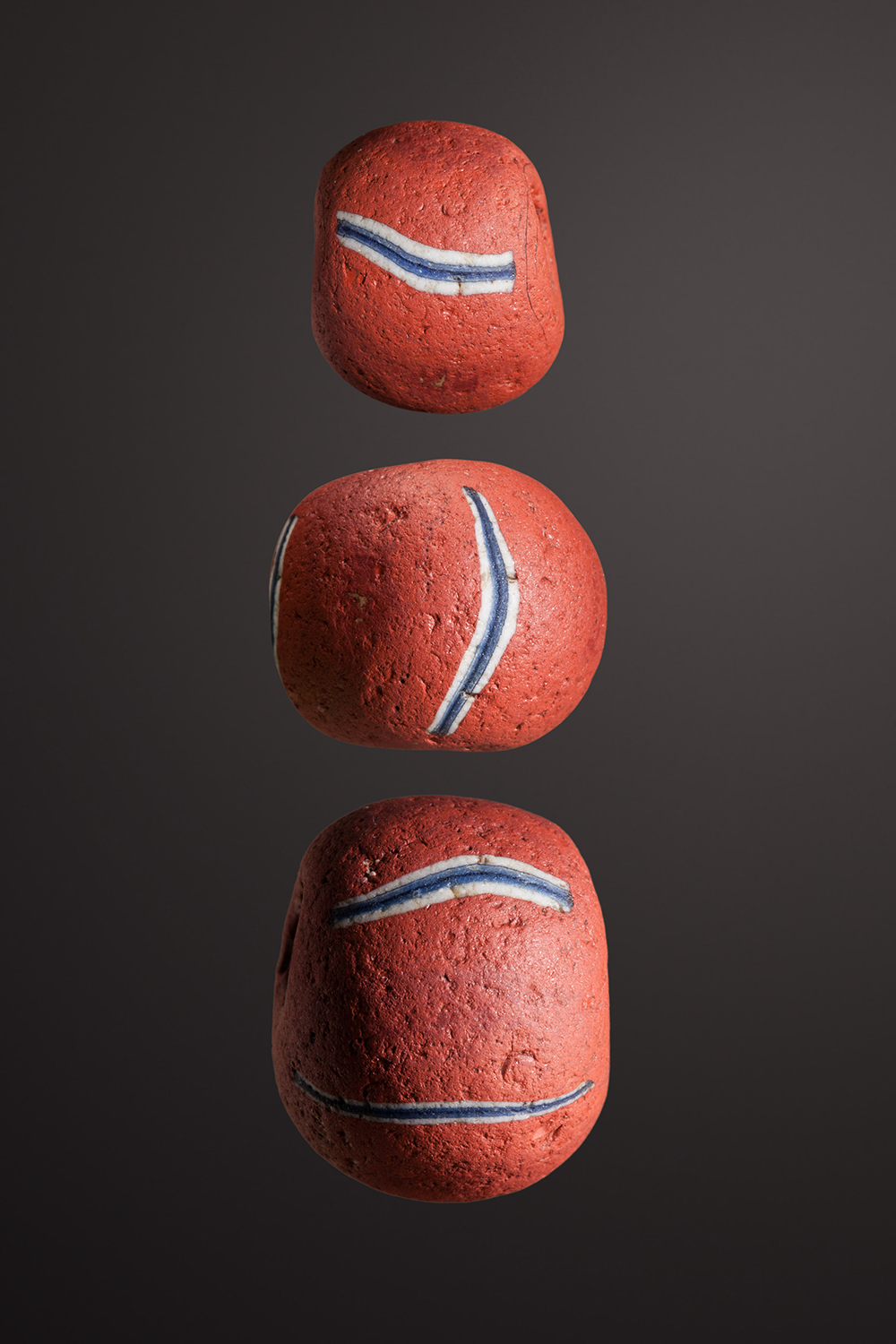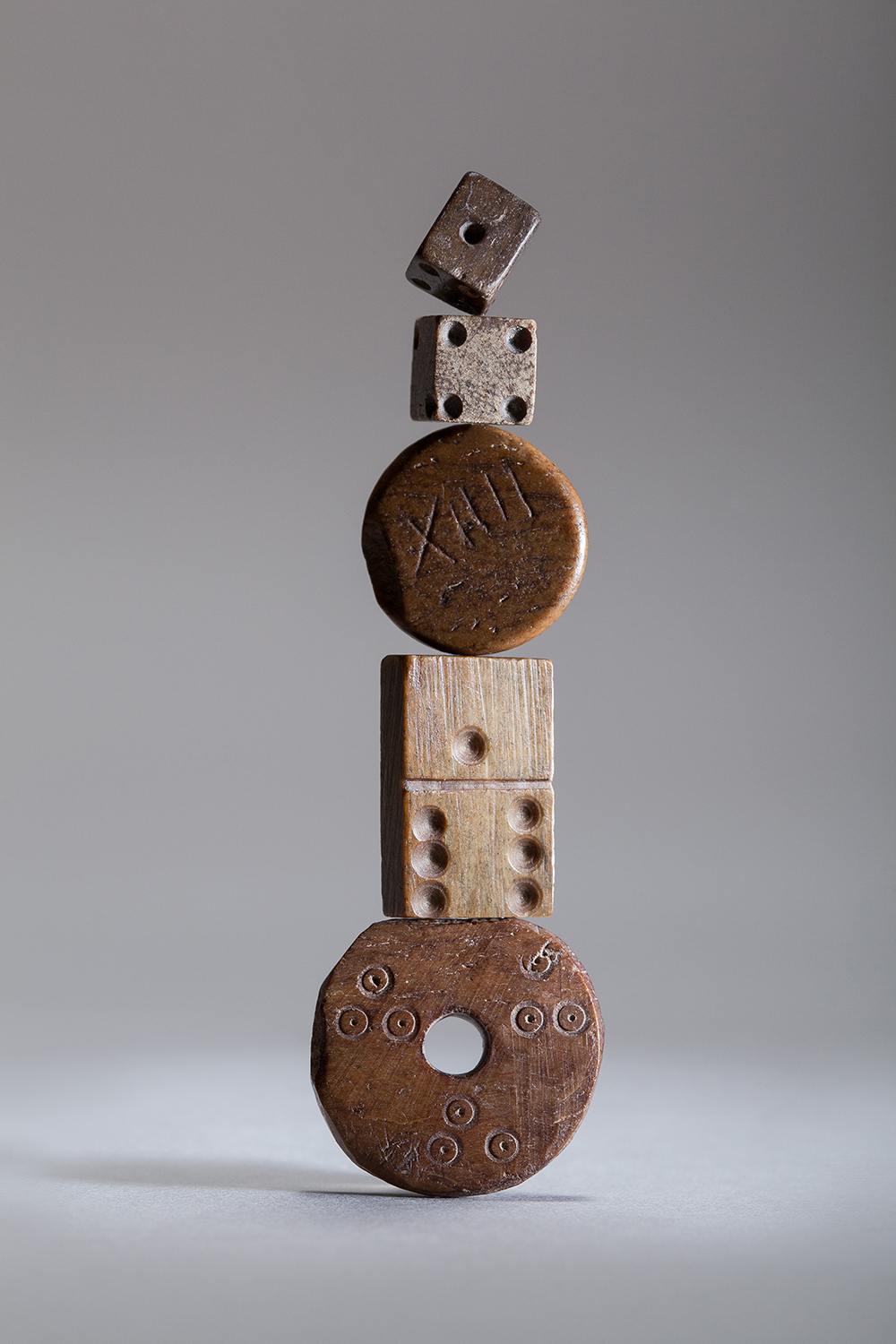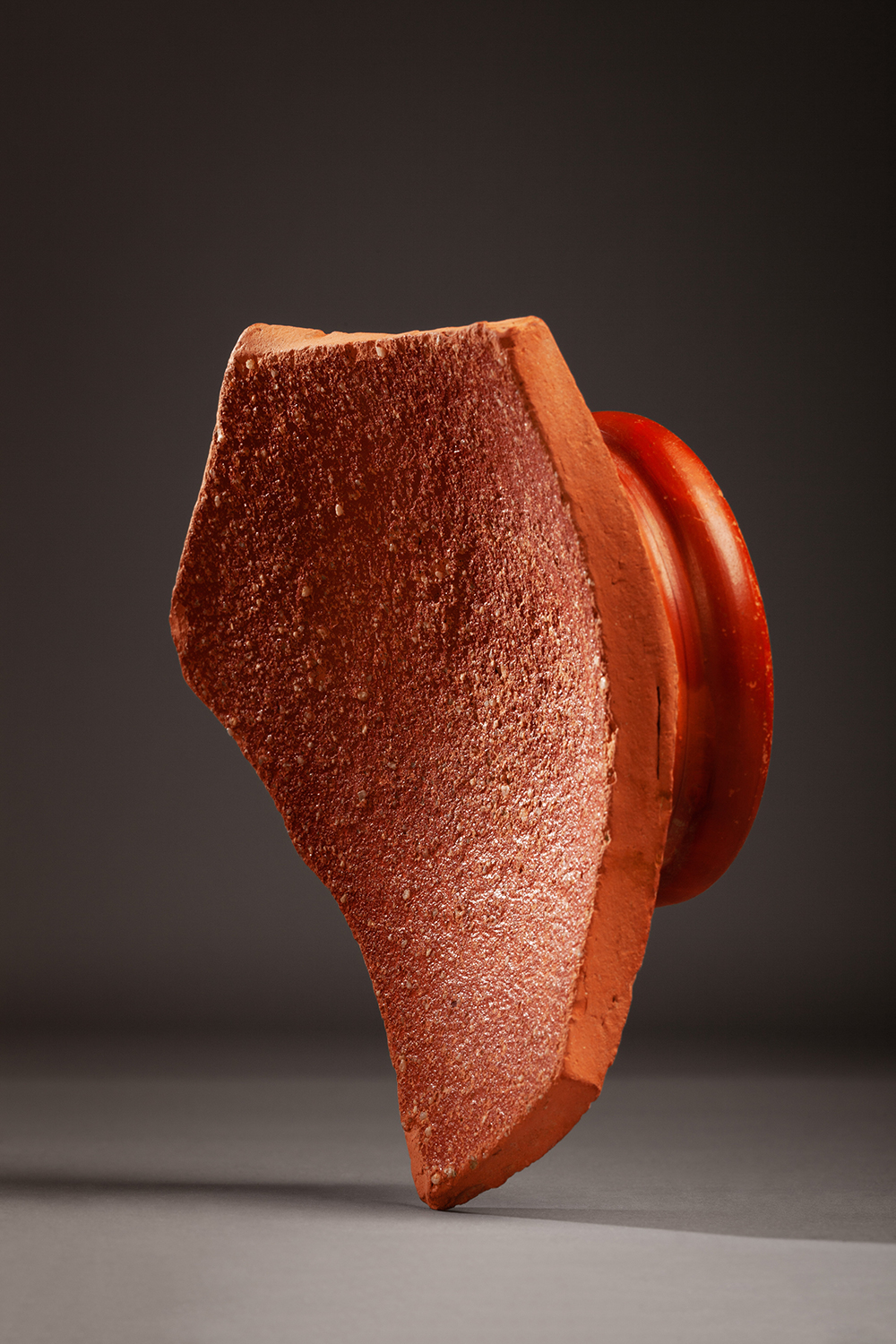
Mudlark
Noun| a person who gains a livelihood by searching for iron, coal, old rope, etc, in mud or low tide on the river foreshoreI photographed artefacts that were found along the banks of the River Thames by some of London’s most prolific mudlarkers. The work culminated in a self-funded exhibition and won a place in the line-up of events for the Totally Thames Festival in September 2018.
Clay Pipe Bowl, Slave Head; c. mid-19th century
William Wilberforce’s Slave Trade Act of 1807 precipitated the abolition of the slave trade in the British Empire, but it was not until the Slavery Abolition Act of 1833 that it was finalised. At the time, it was not unusual for pipes to depict slaves’ heads. The use of anti-slavery imagery on pipes when tobacco was largely produced on Virginian plantations using slave labour, could not have been lost on the smoker. Other examples featured the image of a slave kneeling in chains, originally distributed on Wedgewood cameos with the anti-slavery slogan, ‘Am I not a man and a brother?’ Later pipes commemorating the abolition of the slave trade showed figures with their arms raised as their chains fell away, to represent liberty.
Courtesy of Susie White, Curator, The National Pipe Archive
Exhibition Info:
Art Hub Gallery, Deptford, 12-16 Sept 2018
“Modern mudlarks are a far cry from those Victorian scavengers, usually children, who trudged the tidal waters of the Thames in search of lumps of coal or scraps of metal to sell for a crust. Today, mudlarking has become a recreational pastime, for history-hunters, artists, or simply individuals seeking shoreline respite from the hustle and bustle of the city. It is undeniably a way to connect with both our urban and natural environments, and a special place where the past meets the present. The River Thames is the longest continuous archaeological site in Britain – the cumulative rubbish dump of thousands of years of habitation.
The range of objects eroding from the mud with every tide is astonishing: from Neolithic flint tools, to Roman detritus, pottery and glassware across the centuries to animal bones and human teeth, religious curios, relics of war, children’s toys or yesteryear’s fashions – pins, jewels, buckles, buttons, leather and cloth and clasps.
Art Hub Gallery, Deptford, 12-16 Sept 2018
“Modern mudlarks are a far cry from those Victorian scavengers, usually children, who trudged the tidal waters of the Thames in search of lumps of coal or scraps of metal to sell for a crust. Today, mudlarking has become a recreational pastime, for history-hunters, artists, or simply individuals seeking shoreline respite from the hustle and bustle of the city. It is undeniably a way to connect with both our urban and natural environments, and a special place where the past meets the present. The River Thames is the longest continuous archaeological site in Britain – the cumulative rubbish dump of thousands of years of habitation.
The range of objects eroding from the mud with every tide is astonishing: from Neolithic flint tools, to Roman detritus, pottery and glassware across the centuries to animal bones and human teeth, religious curios, relics of war, children’s toys or yesteryear’s fashions – pins, jewels, buckles, buttons, leather and cloth and clasps.
The Society of Thames Mudlarks has 52 registered members, all Thames historians in their own right, but anyone can obtain a license from the Port of London Authority to search the foreshore. Finds over 300 years old are recorded with the Portable Antiquities Scheme at the Museum of London.
It is not the pursuit or portrayal of ‘treasure’ that fascinates Hannah, but the transformative journey these objects have taken from being every day pieces of rubbish, that can hint at even a small tale of the city’s past, to becoming highly valued, cherished items for the finder.”
Exhibition Info and details of the finds below are written by exhibition curator Florrie Evans
Clay Pipe Stems, c. 16th-19th century
These pipe stems were collected by Hannah on the foreshore in Greenwich.
Her interest in mudlarkers was piqued after a Sunday afternoon stumble along the tideline of animal bones that stretch the length of the Greenwich foreshore.
It is not the pursuit or portrayal of ‘treasure’ that fascinates Hannah, but the transformative journey these objects have taken from being every day pieces of rubbish, that can hint at even a small tale of the city’s past, to becoming highly valued, cherished items for the finder.”
Exhibition Info and details of the finds below are written by exhibition curator Florrie Evans
Clay Pipe Stems, c. 16th-19th century
These pipe stems were collected by Hannah on the foreshore in Greenwich.
Her interest in mudlarkers was piqued after a Sunday afternoon stumble along the tideline of animal bones that stretch the length of the Greenwich foreshore.

 Convict Gallows Token, 1677
Convict Gallows Token, 1677This Charles II penny was rubbed flat before being scribed by an unknown soul in 1677. Presumably it was made for either a family member or friend as a forget-me-not, or to sell for food and better treatment to make a prsion term more comfortable. Courtesy of Steve Brooker & Terry Seddon
 Musket Ball Retrievers, c. 17th century
Musket Ball Retrievers, c. 17th centuryMuskets first came into use in Europe in the early 16th century, and by the 17th century were ubiquitous, not just in warfare. ‘Musket’ continued as the name given for any long gun with a flintlock until the mid-1800s. Musket ball retrievers would have been a must-have for any ships’ surgeon. Courtesy of Nick Stevens
 Roman Oil Lamp, c. AD70-150
Roman Oil Lamp, c. AD70-150Loeschcke Type 9b derivative Unusual because it was made in London, not imported from other Roman territories.
Verularium/London region mica-dusted ware.
Holds 28.5ml of oil/burning for 2-3 hours. Courtesy of Monika Buttling-Smith

Plastic Toys, 20th century-present
These toys were collected over several years by artist and prolific mudlarker, Nicola White.
Hannah created a globe sculpture from the collection to represent the ever-growing problem of plastic pollution in our rivers and oceans.
For more than 50 years, global production and consumption of plastics has continued to rise exponentially. It is calculated that every year at least 8 million metric tons of plastic debris end up in our oceans, for which our rivers are the conduit. Children's toys are perhaps the most poignant plastic waste to be found, bringing to mind the innocence of childhood, but also our failure as a population to preserve the planet for future generations. Courtesy of Nicola White
These toys were collected over several years by artist and prolific mudlarker, Nicola White.
Hannah created a globe sculpture from the collection to represent the ever-growing problem of plastic pollution in our rivers and oceans.
For more than 50 years, global production and consumption of plastics has continued to rise exponentially. It is calculated that every year at least 8 million metric tons of plastic debris end up in our oceans, for which our rivers are the conduit. Children's toys are perhaps the most poignant plastic waste to be found, bringing to mind the innocence of childhood, but also our failure as a population to preserve the planet for future generations. Courtesy of Nicola White
 Apothecary Bottle, c. 18th century
Apothecary Bottle, c. 18th centuryThis bottle most likely originated from a surgeon's supplies aboard a ship. Ships' surgeons were often endowed with over 200 medicinal ingredients for any one journey. When this bottle was found, remarkably lying on the surface of the foreshore, it was filled with a black silt that comprised of Thames mud but also the original, questionable contents! The glass is patinated with swirls typical of Thames-found glass of this era. Courtesy of Florrie Evans
 Trade Bead, c. 18th/19th century
Trade Bead, c. 18th/19th centuryBeads like this played an important part in history - trade (or slave) beads as they were called, were relatively cheaply made trinkets used in exchange for spice's, precious metals, gem's and even people. Sometimes called aggry beads, they were mostly made by Venetian’s cleverly using striped glass canes to create striped or flower patterns. Courtesy of Terry Seddon
 Whale Bone, c. 18th or early 19th century
Whale Bone, c. 18th or early 19th centuryFound on a stretch of river which was the main port for London’s Atlantic whaling fleet. The whales were harpooned off Greenland for their baleen (blubber) and bones. They were finally offloaded from the Thames into boiling houses alongside the docks, where their remains were rendered into oil, or repurposed by sailors for emergency repairs and in foreshore structures. Courtesy of Alan Murphy
 Copper Alloy Religious Cross with wooden inlay, early 20th century
Copper Alloy Religious Cross with wooden inlay, early 20th centuryThought to be a piece of trench art from the First World War, incorporating wood taken from timbers used to build the trenches. In this way the maker has directly juxtaposed a soldier’s sacrifice with that of Christ on the cross. Courtesy of Nick Stevens
 Dutch Copper Alloy Tobacco Tin. c. mid-18th century
Dutch Copper Alloy Tobacco Tin. c. mid-18th centuryInscribed but now no longer legible, presumably with a moral motto or rhyme relating to the tavern scenes depicted. In one of the panels a man sits at a table with a woman on his knee and another serving; on the lid a woman is serving with a beaker, and on the base a man is serving and appears to have dropped a plate. Amusing yet moralizing scenes such as this often derived from popular prints after paintings by the likes of Pieter Breughel the Elder and his circle. Courtesy of Simon Bourne
 Fossilised Infant Wooly Mammoth Tooth (mammuthus primigenius)
Fossilised Infant Wooly Mammoth Tooth (mammuthus primigenius)Ice Age (Pleistocene Epoch, around 2 million years old)
This rare and near-complete tooth comes from a young animal and would have been shed from an early round of teeth. Mammoths had six rounds of teeth through their life-cycle, designated as P2, P3, P4, and M1, M2, M3. By size, this is probably from stage P3. Courtesy of Alan Murphy
 Hand-carved Bone Gaming Pieces
Hand-carved Bone Gaming PiecesThe dice and domino are c. 17th Century. The 'XIII' piece is Roman, AD 100-300. The piece with three sets of dots is medieval, it measures 1 inch in diameter. Courtesy of Jason Sandy
 Pre-Nazi Swastika (9ct gold, 1x1 cm) balanced on the head of a Tudor Pin
Pre-Nazi Swastika (9ct gold, 1x1 cm) balanced on the head of a Tudor PinDated 1910 and created by jeweller Charles Horner of Chester. Probably once part of a pin or charm bracelet. Swastikas are a religious symbol in Buddhism and Hindusim and were used as a good luck charm in Europe long before the Nazi appropriation. Courtesy of Anna Borzello
 Roman Samian Mortarium (grinding bowl), c.
200-400 AD
Roman Samian Mortarium (grinding bowl), c.
200-400 ADUsed to grind herbs and spices for food. Courtesy of Monika Buttling-Smith

Medieval Pilgrim Badge, c. 1300-1500, depicting the martyrdom of Thomas Becket (Archbishop of Canterbury)
This Medieval lead alloy incomplete openwork pilgrim badge, depicts the martyrdom of Thomas Becket. Inside the architectural frame and beneath a tower gate, bowing his head Thomas waits for the final sword blow. At his left, there is a standing knight holding a sword, ready to strike. Becket is shown dressed in the Archbishop's ecclesiastic costume, including mitre and chasuble with decorated collar.
The knight wears a mail hood under his conical helmet. On the back of the badge there are eight small folded-over triangular tabs. These originally would have secured a thin background, probably in a different material e.g. paper, against the back of the badge. The pin and the pin-catch tab are still attached to the back of the badge.
Pilgrim badges are the most appreciated finds among mudlarks, and they represent an early form of social life, which combined elements of travelling for pleasure with piety. The same as today's tourism souvenirs, the badges were used as tangible evidence of holy journeys, or used as protective talismans against any possible dangers occurring during the return trip from a pilgrimage place. They were designed to be worn, fitted with pins or stitched to the clothing and hats.
Dimensions: Length: 73.35 mm; Width: 35 mm; Weight: 7.9 g; Thickness: 1.1 mm Words & artefact courtesy of Tony Thira
This Medieval lead alloy incomplete openwork pilgrim badge, depicts the martyrdom of Thomas Becket. Inside the architectural frame and beneath a tower gate, bowing his head Thomas waits for the final sword blow. At his left, there is a standing knight holding a sword, ready to strike. Becket is shown dressed in the Archbishop's ecclesiastic costume, including mitre and chasuble with decorated collar.
The knight wears a mail hood under his conical helmet. On the back of the badge there are eight small folded-over triangular tabs. These originally would have secured a thin background, probably in a different material e.g. paper, against the back of the badge. The pin and the pin-catch tab are still attached to the back of the badge.
Pilgrim badges are the most appreciated finds among mudlarks, and they represent an early form of social life, which combined elements of travelling for pleasure with piety. The same as today's tourism souvenirs, the badges were used as tangible evidence of holy journeys, or used as protective talismans against any possible dangers occurring during the return trip from a pilgrimage place. They were designed to be worn, fitted with pins or stitched to the clothing and hats.
Dimensions: Length: 73.35 mm; Width: 35 mm; Weight: 7.9 g; Thickness: 1.1 mm Words & artefact courtesy of Tony Thira
 Art Deco Moulded Glass Buttons, c. 1920s-1940s
Art Deco Moulded Glass Buttons, c. 1920s-1940s“Buttons and beads are for me the greatest joy to retrieve from the river - tiny bits of social history they hide the most personal stories.” Courtesy of Florrie Evans
 Tudor, Bone Bodkin/Ear Scoop, c. mid-1500's
Tudor, Bone Bodkin/Ear Scoop, c. mid-1500'sUsed to remove wax from the ear, and also to thread laces through material.
The extracted wax was used to set frayed threads so they could be threaded easier. Courtesy of Monika Buttling-Smith
 Fragments of Large Iridescent Glass Bottles in a Jar, c. 18th-19th century
Fragments of Large Iridescent Glass Bottles in a Jar, c. 18th-19th centuryThis rainbow iridescence is caused by the acidic river water leaching alkali salts from the glass, forming fine adn flaky layers on its surface that reflect light with a prism effect. Courtesy of Anna Borzello
 Combed Staffordshire Slipware Sherds, c.18th century
Combed Staffordshire Slipware Sherds, c.18th centuryBy the mid-1600s, slipware manufacture was well established in England, and by the late 18th century it was the tableware of choice. Courtesy of Ted Sandling
 Peterborough Ware: Mortlake/Fengate type, body sherd of round-based bowl
Peterborough Ware: Mortlake/Fengate type, body sherd of round-based bowlMiddle Neolothic 3,400BC-2800BC (5,400-4,800 years old). With bird bone and fingertip/nail decoration. Courtesy of Mike Webber
 From top: Roman Copper Alloy Nummus of Constantine AD.307-337.
From top: Roman Copper Alloy Nummus of Constantine AD.307-337.- 17th Century Traders Token, issued by Dan Vos in Wapping, London, dating from AD1648-1674. Legend reads: WAPPIN * GOVLDEN CROS.
- 17th Century Traders Token halfpenny of Edmund Warner from Newgate Market, London, dated AD 1666.
Legend reads: .*./MARKET/ HIS . HALF/ *PENNY*/ 1666 Courtesy of Nick Stevens
 Millefiori (‘mosaic’) Trade Bead, c. 18th century
Millefiori (‘mosaic’) Trade Bead, c. 18th centuryMillefiori - from Italian ‘mille’ (thousand) and ‘fiori’ (flowers), is a glasswork technique most frequently associated with Venetian glassware. ‘Trade’ or ‘slave’ beads were an important element in early trade networks between Europe and Africa. Glassmaking was uncommon in Africa, so the beads were highly sought after from as early as the 15th century when Portuguese trading ships arrived on the coast of West Africa to trade for gold, slaves, ivory and palm oil. Courtesy of Florrie Evans

Alabaster figurine of the Indian spiritual master, Sai Baba (d. 1918), circa 20th century; balanced on a Jurassic period fossilised sea urchin, 'echinoid cidaris'.
Courtesy of Monika Buttling-Smith
 Lead token, and token mould carved into a block of stone, circa 14th – 17th century.
Lead token, and token mould carved into a block of stone, circa 14th – 17th century.These tokens were produced by tradesmen and used to purchase daily essentials in shops, as a low-cost alternative to the expensive silver coins issued by the monarchy. Courtesy of Jason Sandy

Sherd of Tudor green ware
18th Century apothecary bottle neck
16th Century bone tool
Courtesy of Jason Sandy

Clay Pipe Bowl, Slave Head; c. mid-19th century
Courtesy of Susie White, Curator, The National Pipe Archive
Courtesy of Susie White, Curator, The National Pipe Archive
 3 Bones
Found by Hannah, Greenwich foreshore
3 Bones
Found by Hannah, Greenwich foreshore Animal Teeth
Courtesy of Kirsten Downer, Thames21
Animal Teeth
Courtesy of Kirsten Downer, Thames21
 7 Bones
Found by Hannah, Greenwich foreshore
7 Bones
Found by Hannah, Greenwich foreshore Rusty boat hook, c. 18th Century
Rusty boat hook, c. 18th Century 